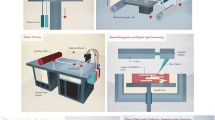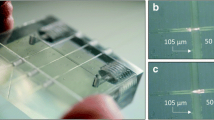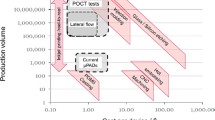Abstract
Recent advancements in 3D printing technology have provided a potential low-cost and time-saving alternative to conventional PDMS (polydimethylsiloxane)-based microfabrication for microfluidic systems. In addition to reducing the complexity of the fabrication procedure by eliminating such intermediate steps as molding and bonding, 3D printing also offers more flexibility in terms of structural design than the PDMS micromolding process. At present, 3D-printed microfluidic systems typically utilize a relatively ‘stiff’ printing material such as ABS (acrylonitrile butadiene styrene copolymers), which limits the implementation of large mechanical actuation for active pumping and mixing as routinely carried out in a PDMS system. In this paper, we report the development of an active 3D-printed microfluidic system with moving parts fabricated from a flexible thermoplastic elastomer (TPE). The 3D-printed microfluidic system consists of two pneumatically actuated micropumps and one micromixer. The completed system was successfully applied to the detection of low-level insulin concentration using a chemiluminescence immunoassay, and the test result compares favorably with a similarly designed PDMS microfluidic system. Prior to system fabrication and testing, the material properties of TPE were extensively evaluated. The result indicated that TPE is compatible with biological materials and its 3D-printed surface is hydrophilic as opposed to hydrophobic for a molded PDMS surface. The Young’s modulus of TPE is measured to be 16 MPa, which is approximately eight times higher than that of PDMS, but over one hundred times lower than that of ABS.














Similar content being viewed by others
References
Au AK, Bhattacharjee N, Horowitz LF, Chang TC, Folch A (2015) 3D-printed microfluidic automation. Lab Chip 15:1934–1941. doi:10.1039/c5lc00126a
Bélanger MC, Marois Y (2001) Hemocompatibility, biocompatibility, inflammatory and in vivo studies of primary reference materials low density polyethylene and polydimethylsiloxane: a review. J Biomed Mater Res 58:467–477
Holden G (2000) Understanding thermoplastic elastomers. Hanser Verlag, Munich
Iso B, Standard B (2009) Biological evaluation of medical devices. Part 1:10993
Jung JH, Kim G-Y, Seo TS (2011) An integrated passive micromixer–magnetic separation–capillary electrophoresis microdevice for rapid and multiplex pathogen detection at the single-cell level. Lab Chip 11:3465–3470
Kim D, Oh H, Park T, Choo J, Lee SH (2005) An easily integrative and efficient micromixer and its application to the spectroscopic detection of glucose-catalyst reactions. Analyst 130:293–298
Kitson PJ, Rosnes MH, Sans V, Dragone V, Cronin L (2012) Configurable 3D-Printed millifluidic and microfluidic ‘lab on a chip’ reactionware devices. Lab Chip 12:3267–3271. doi:10.1039/c2lc40761b
Kong MC, Salin ED (2012) Micromixing by pneumatic agitation on continually rotating centrifugal microfluidic platforms. Microfluid Nanofluid 13:519–525
Lai H, Folch A (2011) Design and dynamic characterization of “single-stroke” peristaltic PDMS micropumps. Lab Chip 11:336–342. doi:10.1039/c0lc00023j
Lai H-C, Wang C-H, Liou T-M, Lee G-B (2014) Influenza A virus-specific aptamers screened by using an integrated microfluidic system. Lab Chip 14:2002–2013
Lawton RA, Price CR, Runge AF, Doherty WJ, Saavedra SS (2005) Air plasma treatment of submicron thick PDMS polymer films: effect of oxidation time and storage conditions. Colloids Surf, A 253:213–215
Lee JM, Zhang M, Yeong WY (2016) Characterization and evaluation of 3D printed microfluidic chip for cell processing. Microfluid Nanofluid 20:5
Legge NR, Holden G, Schroeder H (1987) Thermoplastic elastomers: a comprehensive review. Carl Hanser Verlag, Munchen
Ping Z, Nguyen Q, Chen S, Zhou J, Ding Y (2001) States of water in different hydrophilic polymers—DSC and FTIR studies. Polymer 42:8461–8467
Plecis A, Chen Y (2007) Fabrication of microfluidic devices based on glass-PDMS-glass technology. Microelectron Eng 84:1265–1269. doi:10.1016/j.mee.2007.01.276
Ratner DM, Murphy ER, Jhunjhunwala M, Snyder DA, Jensen KF, Seeberger PH (2005) Microreactor-based reaction optimization in organic chemistry glycosylation as a challenge. Chem Commun. doi:10.1039/b414503h
Rose P, Mark H, Bikales N, Overberger C, Menges G, Kroschwitz J (1987) Encyclopedia of polymer science and engineering Mark, HF: 488
Shankar R, Raravikar NR, Xu D (2010) Self-healing thermal interface materials for semiconductor packages
Sochol R et al (2016) 3D printed microfluidic circuitry via multijet-based additive manufacturing. Lab Chip 16:668–678
Spontak RJ, Patel NP (2000) Thermoplastic elastomers: fundamentals and applications. Curr Opin Colloid Interface Sci 5:334–341
Stjernstrom M, Roeraade J (1998) Method for fabrication of microfluidic systems in glass. J Micromech Microeng 8:33–38. doi:10.1088/0960-1317/8/1/006
Sundararajan N, Kim D, Berlin AA (2005) Microfluidic operations using deformable polymer membranes fabricated by single layer soft lithography. Lab Chip 5:350–354
Thangawng AL, Ruoff RS, Swartz MA, Glucksberg MR (2007) An ultra-thin PDMS membrane as a bio/micro-nano interface: fabrication and characterization. Biomed Microdevice 9:587–595. doi:10.1007/s10544-007-9070-6
Wang Z (2011) Polydimethylsiloxane mechanical properties measured by macroscopic compression and nanoindentation techniques. University of South Florida
Wang JD, Douville NJ, Takayama S, ElSayed M (2012) Quantitative analysis of molecular absorption into PDMS microfluidic channels. Ann Biomed Eng 40:1862–1873
Yao P, Tung S, Zhan Z, Hua J, Dong Z (2013a) Development of microfluidic-based telemedicine for diabetes care and screening. Trans Inst Meas Control 35:893–900. doi:10.1177/0142331212455449
Yao P, Xie S, Liu Z, Dong Z, Liu L, Wang W, Tung S (2013) Combined experimental and numerical simulation study of PDMS pneumatic micropumps. In: Nano/Molecular medicine and engineering (NANOMED), 2013 IEEE 7th International Conference on, 2013b. IEEE, pp 130–133
Yao P, Liu Z, Tung S, Dong Z, Liu L (2016) Fully automated quantification of insulin concentration using a microfluidic-based chemiluminescence immunoassay. J Lab Autom 21:387–393
Young WC, Budynas RG (2002) Roark’s formulas for stress and strain, vol 7. McGraw-Hill, New York
Zhang WJ, Choi DS, Nguyen YH, Chang J, Qin LD (2013) studying cancer stem cell dynamics on PDMS surfaces for microfluidics device design. Sci Rep 3:8. doi:10.1038/srep02332
Zhou J, Ellis AV, Voelcker NH (2010) Recent developments in PDMS surface modification for microfluidic devices. Electrophoresis 31:2–16
Acknowledgements
This paper is supported by the National Natural Science Foundation of China (Grant No. 61573339) and the CAS FEA International Partnership Program for Creative Research Teams. The authors would like to thank Mrs. E.M. Martin and J. Hockman for their assistance with cell cultures and sample preparation.
Author information
Authors and Affiliations
Corresponding authors
Rights and permissions
About this article
Cite this article
Wang, J., McMullen, C., Yao, P. et al. 3D-printed peristaltic microfluidic systems fabricated from thermoplastic elastomer. Microfluid Nanofluid 21, 105 (2017). https://doi.org/10.1007/s10404-017-1939-y
Received:
Accepted:
Published:
DOI: https://doi.org/10.1007/s10404-017-1939-y




